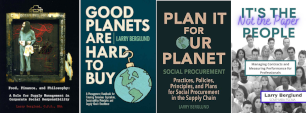To appreciate the shift towards Environmental and Social Governance (ESG) practices, we need to look at earlier business strategies. First, was the Corporate Governance mandate to make money. It turned out that generating profits was being conducted by any means possible with the unfettered zeal of shareholders to maximize their returns.
These returns were often at the expense of the environment and were indifferent to social responsibilities, beyond paying taxes. Corporate Social Responsibility policies were drafted as a response to appease critics of the profits only mandate; however, CSR appeared to be more of an attempt to address image rather than have a social impact or mitigate environmental degradation.
The E for environmental, in ESG, has been the focus with a shift in direction towards social values. Stakeholder capitalism (community interests) is not displacing shareholder capitalism (corporate interests), but it is gaining leverage to balance these competing objectives. Social procurement policies stem from the S in ESG.
All businesses and governmental operations have supply chains and budgets as a common denominator. By extension, ESG should be a part of supply chain strategies across these sectors. The largest player on the demand side is public sector procurement. Public procurement is the means by which all levels of government monetize policies when sourcing goods and services.
If the weighting on ESG criteria is lesser than that of pricing, the supply side will not move the needle. If government policies don’t incentivize higher commitments to achieving measurable social outcomes or reducing harmful emissions in their competitive bidding documents, the supply side won’t invest in more sustainable solutions. Sustainable solutions don’t necessarily equate to higher costs.
An example is the demand for school buses in Canada. The status quo is to continue to buy new gas/diesel powered buses. Quebec-based Lion Electric makes e-buses and in BC, the Riise EV company is converting internal combustion engine (ICE) vehicles into e-vehicles (EV), which could include school buses. This $30B dollar bus market favours the ICE models and the dramatic payback for converting to EV buses is being discounted. The payback on conversion reduces capital costs by 50% along with 75% lower operating costs. The education sector can contribute more to the various governmental emission reduction programs, support new jobs in Canada, advance the transition to renewable energy, and realize savings in their budgets says Dean Kneider, President and CEO of Riise EV. Buying groups sourcing ICE models remain less than objective and not assertive on scrutinizing e-bus options. Government can be more proactive and prioritize the ICE to EV conversions concurrent with buying new EV buses and vehicles.
The private sector is cognizant of stakeholder interests; however, post pandemic pressures such as extreme inflation and across-the-board shortages are downplaying ESG as a priority. Globe and Mail writer Jeff Jones, stated in a July 2022 article that “in good times, we can afford everything; in tough times, we reset our priorities.” We are facing wars, inflation, economic uncertainty, political polarization and therefore, ESG interest abates.
ESG, while not a panacea, is a stronger commitment by corporations to participate in solutions to global problems. Issues such as climate change, human trafficking, workers’ rights, renewable energy, inclusivity, reducing inequality, and poverty. These social externality costs are being factored into the private sector policies. ESG practices are a means of validating the social license granted to companies in free markets. The UN Sustainable Development Goals are being adopted by forward looking companies as a framework for their ESG policies. Consumers, customers, and communities are a critical part of the demand side, and will buy products labelled as being socially or environmentally responsible.
Compounding the challenges to ESG from a private sector perspective, is the lack of evidence that there is a correlation between improved financial performance and ESG policies being in place. There are a few claims of shareholders having satisfactory returns where companies have adopted ESG policies but they are the few, not the many. Stating this in another way, investors want their corporate governance expectations to continue and environmental and social issues are a distraction.
Adding to the ESG perplexity are the reporting metrics. Self-appointed, 3rd party agencies use their own methods for calculating results. Without a recognized set of reporting outcomes or definitions, it is difficult to find credibility in reports and support increased pressure for the supply side to improve. Scope 1, 2, and 3 emissions, supplier diversity, green products, green operations, anti-corruption, or carbon offset project returns can all be part of this reporting miasma.
Despite the difficulties in measuring and reporting on ESG progress, these should not be seen as an excuse to avoid best practices in environmental and social governance in our supply chains. When we take on these challenges, we get better at creating solutions. We increase our awareness; which leads to advocacy; which leads to actions.
Per Darren Gee, CEO of Peyto Exploration & Development Corp out of Calgary: “There is a rush to create a system of governance on supply, which has no impact on demand. While the latter is what we want to change.” Per Larry Fink, CEO of BlackRock Inc., “The power of capitalism is driven by mutually beneficial relationships between you and the employees, customers, suppliers, and the communities your company relies on to prosper.” This statement captures the reason d’etre for ESG.
Purposeful leadership, with accountability, will drive the changes in the market to achieve the intended outcomes. Technology and social conscientiousness in business decisions will result in sustainable economic returns. Science should have a loud voice at the ESG table and have the ear of the supply and the demand sides in the conversations which ensue.
Supply chain professionals should lean in and ensure ESG is in their policies and deployed in their practices. They are the demand managers for the goods and services we all acquire. The supply side and consumers will respond accordingly. What’s in your school bus?

